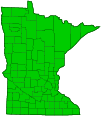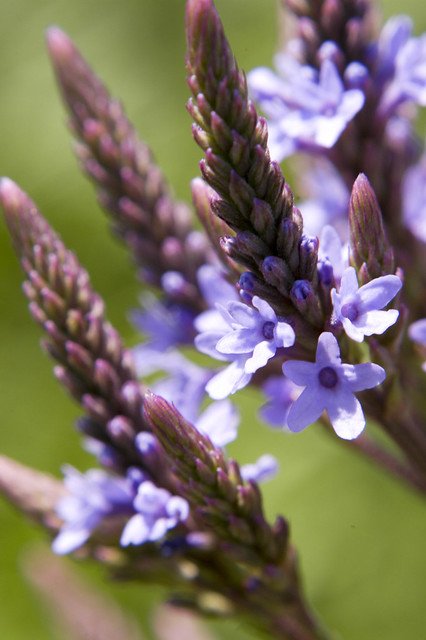blue vervain
(Verbena hastata)
Conservation • Wetland • Description • Habitat • Ecology • Use • Distribution • Taxonomy
Description |
||
Blue vervain is an erect, perennial forb that rises on one or two stems from an underground horizontal stem (rhizome) and fibrous roots. It is usually 16″ to 60″ tall, though in favorable conditions it may reach more than 7′ in height. It often forms colonies. The stems are annual, erect, stout, moderately to strongly square, and branched near the top. They are green to reddish and moderately to densely covered with spreading to appressed hairs. The leaves are opposite, lance-shaped to oblong lance-shaped or narrowly egg-shaped, 1½″ to 8″ long, and ⅝″ to 1¾″ wide. They are about 5 times as long as wide. They are on short, ⅜″ to 1″ long leaf stalks (petioles). The petioles are usually winged toward the top. The leaf blades are rounded, angled, or short tapered at the base, and tapered to a sharp point at the tip. They do not clasp the stem at the base. They have a prominent midvein, several lateral veins that arch toward the tip, and a network of smaller veins between the lateral veins. The lateral veins end before reaching the margin. The upper and lower surfaces are green and sometimes rough to the touch. They are sparsely to moderately covered with short, inconspicuous, loosely appressed, non-glandular hairs. The margins are coarsely toothed with sharp, forward pointing teeth. There are often two, sometimes only one, narrow, forward pointing lobes at the base of the larger leaves, and there is often a pair of small leaves rising from the leaf axils. The inflorescence is a branched group (panicle) of 5 to many spikes at the end of the stem and branches. The spikes are erect or strongly ascending, unbranched, ¾″ to 8″ long, and noticeable pointed at the tip. They are short and moderately stout when young, greatly elongated and slender at maturity. The flowers are densely crowded and spirally arranged on the spike. They bloom from the bottom up and only one to a few complete rotations of the spiral are in bloom at any one time. Each blooming flower overlaps adjacent blooming flowers. Each flower is ⅛″ to ¼″ in diameter. There are 5 sepals, 5 petals, 4 stamens, and 1 style. The sepals are green, and are united at the base into a narrowly bell-shaped tube (calyx), then separated into 5 short teeth that are unequal in length. The calyx is 1 ⁄16″to ⅛″ long. The modified leaves (bracts) at the base of each flower are narrowly lance-shaped, sharply pointed, and 1 ⁄16″to ⅛″ long. They are slightly shorter than the calyx. The petals are purple to purplish-blue, rarely pink or white, and ¼″ to ⅜″ long. They are fused at the base into a slender, funnel-shaped tube then separated into 5 spreading lobes. The lobes are ¼″ to 3 ⁄16″ in diameter and blunt to rounded at the tip. The flowers are not fragrant. Each flower produces a cluster of 4 reddish-brown nutlets that are enclosed in the persistent calyx but are exposed at the tip. Each nutlet is narrowly oblong to narrowly oblong elliptic in outline and 1 ⁄32″ to 1 ⁄16″ long. They may be faintly ridged on the bottom and have a few faint cross ridges toward the top. |
||
Height |
||
16″ to 60″ |
||
Flower Color |
||
Purple to purplish-blue |
||
Similar Species |
||
Blue vervain (Verbena hastata) leaves are not lobed near the base. |
||
Habitat |
||
Moist. Marshes, meadows, fields, swamps, roasdside ditches. Full sun. |
||
Ecology |
||
Flowering |
||
July to September |
||
Pests and Diseases |
||
|
||
Use |
||
|
||
Distribution |
||||
|
Sources |
|||
| 2/25/2023 | ||||
Nativity |
||||
Native |
||||
Occurrence |
||||
Common |
||||
Taxonomy |
|||
| Kingdom | Plantae (Plants) | ||
| Division | Tracheophyta (Vascular Plants) | ||
| Subdivision | Spermatophytina (Seed Plants) | ||
| Class | Magnoliopsida (Dicots) | ||
Order |
Lamiales (Mints, Plantains, Olives, and Allies) | ||
Family |
Verbenaceae (verbena) | ||
| Tribe | Verbeneae | ||
| Genus | Verbena (vervain) | ||
| Section | Verbena | ||
| Series | Candelabrae | ||
Subordinate Taxa |
|||
Some sources, including ITIS, USDA PLANTS, and NatureServe, recognize two varieties: var. hastata, occurring in eastern North America; and var. scabra, with stiffer hairs making the stems and leaves more rough to the touch, occurring in western North America. The ranges of the two varieties overlap broadly in the middle of the continent, and both varieties are found in Minnesota. Steyermark’s Flora of Missouri (Yatskievych, 2006) rejects the separation, stating that the defining characteristics intergrade completely, and some plants in the west have softer hairs. Few other sources recognize the varieties. |
|||
Synonyms |
|||
Common Names |
|||
American blue vervain blue verbena blue vervain Simpler’s-joy swamp verbena wild hyssop |
|||
Glossary
Axil
The upper angle where a branch, stem, leaf stalk, or vein diverges.
Calyx
The group of outer floral leaves (sepals) below the petals, occasionally forming a tube.
Panicle
A pyramidal inflorescence with a main stem and branches. Flowers on the lower, longer branches mature earlier than those on the shorter, upper ones.
Petiole
On plants: The stalk of a leaf blade or a compound leaf that attaches it to the stem. On ants and wasps: The constricted first one or two segments of the rear part of the body.
Rhizome
A horizontal, usually underground stem. It serves as a reproductive structure, producing roots below and shoots above at the nodes.
Sepal
An outer floral leaf, usually green but sometimes colored, at the base of a flower.
Visitor Photos |
|||||
Share your photo of this plant. |
|||||
| This button not working for you? Simply email us at info@MinnesotaSeasons.com. Attach one or more photos and, if you like, a caption. |
|||||
Greg Watson |
|||||
I was riding my bike along the Wagon Wheel Trail in La Crescent this morning and I was able to get these two pictures of a [Broad-headed] Marsh Fly. A first time for me on seeing one. It is on a Blue Vervain, Verbena hastata. |
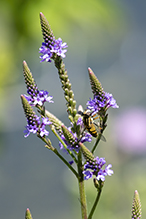 |
||||
Luciearl |
|||||
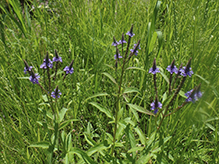 |
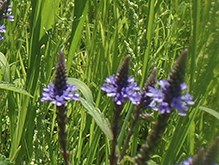 |
||||
Sherrie |
|||||
_07s.jpg) |
|||||
Kirk Nelson |
|||||
Blooming in July on the shore of Snelling Lake |
_05s.jpg) |
||||
_07s.jpg) |
_06s.jpg) |
||||
Done blooming, late September |
_08s.jpg) |
||||
MinnesotaSeasons.com Photos |
|||||
Inflorescence |
|||||
_05s.jpg) |
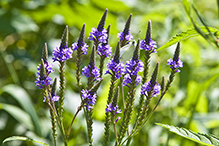 |
||||
Leaves |
|||||
_06s.jpg) |
|||||

Visitor Videos |
|||
Share your video of this plant. |
|||
| This button not working for you? Simply email us at info@MinnesotaSeasons.com. Attach a video, a YouTube link, or a cloud storage link. |
|||
Other Videos |
|||
| Minnesota Native Plant - Blue Vervain (Verbena Hastata) MNNativePlants |
|||
About
Published on Jul 15, 2013 This video shows the Blue Vervain (Verbena Hastata), a beautiful plant for your native water garden or pond. |
|||
| MyNature Apps; Identifying Blue Vervain, Verbena hastata MyNatureApps |
|||
About
Uploaded on Aug 5, 2011 How to identify Blue Vervain, Verbena hastata also known as Verbena, Common Verbena, Common Vervain, Eisenkraut, European Vervain, Herb of Grace, Herb of the Cross, Holy wort, Juno's Tears, Pigeon weed, Simpler's Joy, Turkey Grass, Swamp Vervain, Mosquito Plant, and Wild Hyssop |
|||

Visitor Sightings |
|||||
Report a sighting of this plant. |
|||||
| This button not working for you? Simply email us at info@MinnesotaSeasons.com. Be sure to include a location. |
|||||
| Greg Watson 7/3/2022 |
Location: La Crescent, MN I was riding my bike along the Wagon Wheel Trail in La Crescent this morning and I was able to get these two pictures of a [Broad-headed] Marsh Fly. A first time for me on seeing one. It is on a Blue Vervain, Verbena hastata. |
 |
|||
| Luciearl 7/17/2019 |
Location: Lake Shore, Cass County |
 |
|||
| Sherrie 8/1/2018 |
Location: Lebanon Hills Regional Park (Jensen Lake) |
_07t.jpg) |
|||
| Kirk Nelson 9/27/2015 |
Location: Fort Snelling State Park Done blooming, late September |
_08t.jpg) |
|||
| Kirk Nelson 7/11/2015 |
Location: Fort Snelling State Park Blooming in July on the shore of Snelling Lake |
_07t.jpg) |
|||
| Kirk Nelson 7/8/2015 |
Location: Fort Snelling State Park Blooming in July on the shore of Snelling Lake |
_05t.jpg) |
|||
MinnesotaSeasons.com Sightings |
|||||
Beaver Creek Valley State Park Bertram Chain of Lakes Regional Park Carpenter St. Croix Valley Nature Center Cedar Creek Ecosystem Science Reserve Charles A. Lindbergh State Park Clifton E. French Regional Park Lake Alexander Woods SNA, South Unit Mound Spring Prairie SNA, North Unit Northern Tallgrass Prairie NWR, Hoffman Unit Northern Tallgrass Prairie NWR, Pavia Unit Northern Tallgrass Prairie NWR, Rengstorf Unit Northern Tallgrass Prairie NWR, Touch the Sky Prairie Unit Prairie Creek WMA, Koester Prairie Unit Split Rock Lighthouse State Park Verlyn Marth Memorial Prairie SNA |
|||||

|
Created: Last Updated: © MinnesotaSeasons.com. All rights reserved. |
